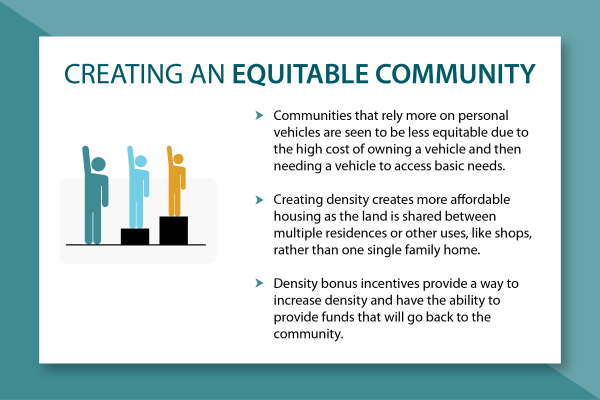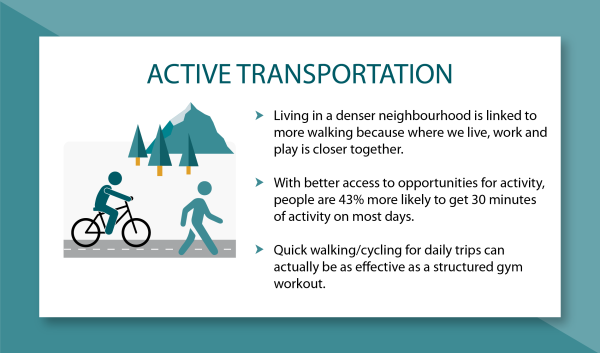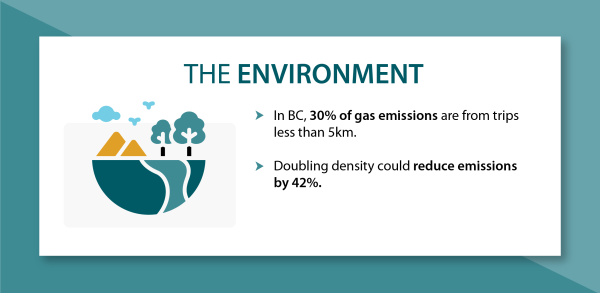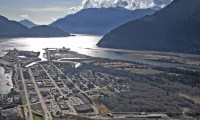Density and Public Health
Densifying Squamish Open House: How Walkable Neighbourhoods Support Community Health
How do changes in neighbourhood density impact health?
Research shows that as communities continue to sprawl, people’s health can be negatively affected. This presentation uncovers how increasing density improves our physical and mental health, and keeps our environment healthy by increasing activity levels, promoting social connectedness, and reducing emissions and our ecological footprint. The presentation will also address how increased density can make Squamish a more equitable community for all residents.
Densifying Squamish Open House
On May 19, 2021 an open house was held with a presentation by University of Victoria Master’s of Public Health Candidate Hope Moir & District Planner Matt Gunn.
You can watch a recording of the open house here:
Learn More
To learn more about the link between density and public health please read through the information below.
More detail can be found in the report “Managing Urban Density and Health in Squamish, BC” by Hope Moir
Introduction
As part of the work to implement the Squamish2040 Official Community Plan through an update to the Zoning Bylaw, staff at the District of Squamish are working to understand the relationship between planning, development and how density can impact the health of a community.
This webpage was created with the help of a Master of Public Health Student from the University of Victoria. The information on this page is a compilation of academic research and a review of municipal programs and projects. The sources linked directly in the content were chosen as they provided the clearest information, as well as being strong syntheses of other studies.
Healthy Built Environment
The human and natural made characteristics of our communities that provide us with a setting for activities to work, live, and play makes up our built environment. Planning decisions such as zoning, public transit, and the design of a community can contribute to a healthy built environment, with the goal to support good health for all.
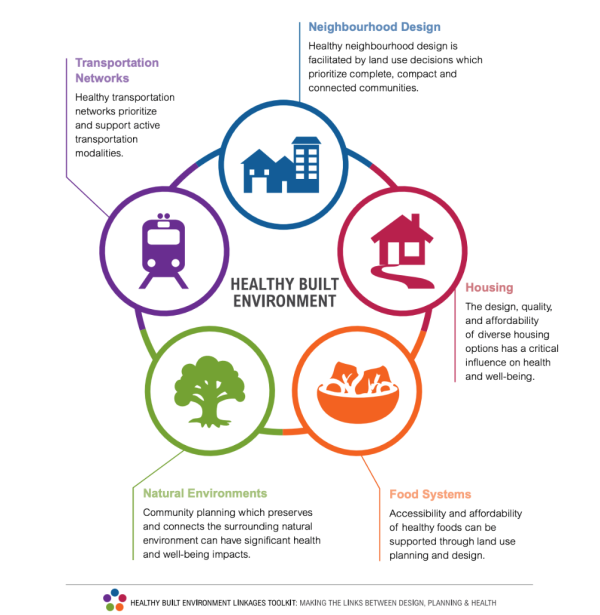
The Case for Density
Squamish has been under steady growth pressure for close to a decade. In the 2016 national census, Squamish was among the 25 fastest growing small Canadian municipalities, reaching a population of 19,512. While average population growth between the 2011 and 2016 censuses was 5.6% provincially and 5.0% nationally, Squamish grew by almost 14% in the same period.
This growth in Squamish is associated with strong local housing demand and is a driving force of both the dramatic increases in housing prices and the significant development cycle currently underway. The amenity-rich outdoor lifestyle is attracting individuals and families who may be employed either locally or in the Lower Mainland, or are able to work remotely. The population boost has come from intra-provincial, inter-provincial and international migration, as well as from a local baby boom. The property development cycle we are currently experiencing is a response to this increased demand, rather than a driver of that demand.
What is Smart Growth
Smart growth is a healthier, more sustainable approach to land use, development and growth planning, and is a widely supported theory to decrease urban sprawl and advocate for more compact and connected communities. When following Smart Growth principles, the goal is to create “compact, transit-oriented, walkable, bicycle-friendly land use, including neighbourhood schools, complete streets, and mixed-use development with a… range of housing choices” (Shrivastava&Sharma,, 2011).
There are 10 principles of Smart Growth:
- Mix land uses
- Build well-designed compact neighbourhoods
- Provide a variety of transportation choices
- Create diverse housing opportunities
- Encourage growth in existing communities
- Preserve open spaces, natural beauty and environmentally sensitive areas
- Protect and enhance agricultural lands
- Utilize smarter and cheaper infrastructure and green buildings
- Foster a unique neighbourhood identity
- Nurture engaged citizens
The Smart Growth Neighbourhood Incentive program is one way Squamish is supporting smart growth and a healthy built environment. Other strategies to address Smart Growth can be found in various sections of the current OCP.
Variations of density
Increasing the density in Squamish neighbourhoods means that places to live, work, and play are closer together and consequently require less reliance on cars for travel. Shaping our neighbourhoods to become denser creates options for work and play in walking/cycling distance or being close to public transit.
Increased density can reflect a range of options and does not imply a community full of high-rise apartments; increased density includes ‘gentle’ changes such as secondary suites, accessory dwelling units such as carriage houses, and housing forms such as duplexes or triplexes that can readily integrate with existing single-family neighbourhoods. In some areas of the community, increased density might encompass a ‘mixed land use’ approach. This typically refers to development where residential units are located on the same land as commercial units. This approach can support several goals of smart growth development.
Heath Impacts
The environment we live in greatly shapes our health, both positively and negatively. The built environment can set us up for success or create major disadvantages, and changes in density play a major role in the built environment. “[L]and use decisions such as zoning, the design of transportation systems and communities influence health significantly. Consider, for instance, the distances people must travel to work, the convenience of buying healthy foods, or the safety of a park: all of these factors can promote good nutrition and physical activity, leading in turn to better mental and physical health” (PHSA, 2009).
The following themes were identified in a literature review as key impacts density can have on the health of a community. The themes are organized under four headings – equity, active transportation, the environment and social connectedness.
Equity
The built environment plays an important role in creating equity in a community. “Health equity is created when individuals have the fair opportunity to reach their fullest health potential. Achieving health equity requires reducing unnecessary and avoidable differences that are unfair and unjust. Many causes of health inequities relate to social and environmental factors including: income, social status, race, gender, education and physical environment.” (Public Health Ontario, 2020).
There are a number of ways in which density can impact equity, and in turn health.
Less reliance on automobiles
Densification enables communities to build a more frequent, reliable and convenient transit network, thus increasing equity in a community. Given that the average Canadian pays between $8,600 and $13,000 annually on personal vehicles, creating car dependent communities can make personal vehicle costs an essential expense to access basic needs. Public transit, on the other hand, costs an average of $39 for a monthly pass, and is consequently accessible to a broader range of community members.
Additionally, this issue is compounded within socio-economic groups already challenged such as new immigrants, seniors unable to drive, or those with chronic mental and/or physical illness. (BCCDC,2018).
Even for children, density can support better access to school and recreation with safer roads and more ability to bike and walk to nearby amenities (Litman, 2020)
Housing diversity
An equitable community includes housing options that are attainable for all people living and employed in the community. Properly executed, increased density has the ability to improve access to housing. While market apartments and townhouses may not be considered affordable, these multi-family housing forms can increase affordability in comparison to single family urban sprawl due to the following reasons:
- Density encourages affordability by decreasing the amount of new land needed for housing, and builds on existing land. Duplexes and triplexes are another example of more affordable options given shared land, shared infrastructure and smaller sizes; this is particularly important for growing and young families. (Esquimalt, 2019).
- Urban sprawl increases the per user costs of public services such as water supply, sanitation, electricity, waste management, road networks, transit, fire protection and policing as neighbourhoods are fragmented. This contributes to either less inclusive cities due to increased costs to the taxpayer, or leads to lower quality services across the community (Litman, 2020).
- Increased density spreads existing infrastructure operations and maintenance costs across more people as opposed to low density development that spreads increased costs across fewer people. This is particularly relevant with respect to ongoing maintenance and replacement costs. By reducing economic strain, growth patterns that increase can better support residents and maintain lower property taxes. (Litman, 2020).
Density bonus systems
New density that is the result of development under a density bonus system can provide additional benefits through amenities that increase community equity:
- Density Bonuses incentivize density while at the same generate funds that can help improve the infrastructure needed for a growing community.
- Funds from these systems can be allocated to amenities such as bike lanes and pedestrian paths, green spaces, housing costs, and more, depending on the needs of the community.
- Density bonus systems are a popular tool for municipalities; a diverse range of these systems are used across both the province and the nation.
Active Transportation
As communities sprawl further from urban areas, travel becomes more reliant on personal vehicles. In contrast, neighbourhoods with higher densities encourage transportation without driving.
The following is an excerpt from the Heart and Stroke Foundation’s Shaping Active, Healthy Communities toolkit to support development of a build environment.
“Low-density, single-land use neighbourhoods and street networks are typically poorly suited to walking. Only about 12% of Canadians’ home-based trips (such as trips to the grocery store, work or school) are made on foot or bicycle, compared with 46% in the Netherlands and 41% in Denmark. Walking and cycling rates are especially low in rural and suburban areas. While 34% of urban residents walk, bike or take public transit to work, only 18% do so in the rest of Canada.” By having more opportunities to be active, it becomes easier for people to meet the daily recommended physical activity levels. For instance, “public transit users often accumulate some or all of the needed 30 daily minutes of physical activity simply by walking to and from transit stops. Factors that encourage public transit use include locating stops close to homes, providing frequent service and ensuring ease of connection with important destinations”.
Density can improve resident health through transportation in several ways:
- For every 5% improvement in walkability of a neighbourhood, residents tend to have a lower Body Mass Index (BMI). Consequently, there is an improvement in the risk of heart disease, stroke, hypertension, type 2 diabetes, among other morbidities related to high BMI (Canadian Institute of Planners, n.d)
- Residential areas that contain a higher proportion of employment space and/or day-to-day services reduce the reliance on personal vehicles. As a result, including commercial land uses within residential neighbourhoods that are outside established commercial areas can increase the likelihood of the use of active modes of transportation. (Canadian Institute of Planners, n.d).
- Traffic injuries and accidents occur more frequently as a result of suburban sprawl. In these areas roads become wider and are built to accommodate increased vehicle traffic, rather than supporting active travel with infrastructure such as bike lanes and sidewalks. When density increases, roadways typically shift to support active travel through increased sidewalk widths, traffic calming measures and traffic mitigating strategies, which encourage less vehicle traffic overall. (Litman,2020).
Trade-offs and considerations:
- While studies show that pedestrian and traffic incidents decrease in denser cities where there are fewer cars on the road, if the pathways and sidewalks are inadequate, the chance of traffic injuries increase. It is important, therefore, that pedestrian infrastructure is invested in and made available as density increases.
- In addition, increases in biking/walking infrastructure can be associated with a loss of vehicle infrastructure, particularly on-street parking.
- Finally, the changes to the infrastructure for active transport come at a financial cost, however, the long-term savings from reduced traffic accidents and less frequent road maintenance may mitigate further transportation related costs (Litman, 2020).
The Environment
As communities grow through patterns of residential sprawl, there tends to be a loss of recreation and environmental values through development of greenfield areas. Largely sprawled communities reliant on personal vehicles to access recreation, work, and other essential needs also contribute to increased emissions.
By contrast, increasing density in communities reduces reliance on personal vehicles which is associated with reduced emissions. By increasing ability for active transportation and/or public transit and increasing land mix use by having more services near our residential neighbourhoods, small trips in a personal vehicle can be avoided (Frank, Kavage, & Litman, 2006).
In contrast to sprawling single family development, a focus on infill density can have a lower impact on air pollution and other environmental values:
- Studies show that by doubling density, we can improve our CO2 efficiency by 42% (Gudipudi et al, 2016)
- Water quality can be impacted if communities sprawl too far out. Research suggests the runoff generated by fringe development to be approximately 10 times greater than that produced by infill (Frank, Kavage, & Litman, 2006). Other studies support that concept that creating density leads to better management of run off. (Canadian Institute of Planners, n.d).
- Moving from single family homes to condos can reduce household ecological footprints related to housing and transportation by 40% (Gurstein, 2012).
- By reducing emissions and improving air quality, some of the injurious impacts of pollution can be mitigated such as lung and heart disease, stroke, and asthma
Furthermore, green spaces are a significant contributing factor to a healthy community; when density increases, it is vital to ensure green spaces are easily accessible. One benefit of dense multi family development over single family development is that, for the same number of dwelling units to accommodate a growing population, it is much easier to preserve the surrounding environmental values and provide more room for green spaces within proximity of residential areas Rather than dedicating land to individual yards for each home, denser residential areas can provide more common green spaces and playgrounds to foster a sense of community and provide immediate access to outdoor space (Happy City, n.d)
Possible trade-offs
- Academic research includes some mixed results regarding the carbon footprint of higher density residential areas. However, in smaller communities such as Squamish, the research shows positive improvement to the carbon footprint per capita with higher density. Ultra-dense environments such as Hong Kong can generate significant amounts of pollution. Although the emissions per may decrease in these environments, the overall exposure to the population is higher given the concentration of emissions in a denser area. This risk is not relevant to a community the size of Squamish.
Social Connectedness
Increasing opportunities for social connections has been shown to increase life expectancy. There are often higher levels of prosperity, a greater sense of community, and lower rates of crime and violence when neighbourhoods are built to support social connections. (Gattino, Piccoli, Fassio & Rollero, 2013). Increasing density has the ability to support better social connectedness in several ways, beyond the result of people’s proximity to each other.
Social connections can be achieved through a density strategy that encourages zoning for mixed land uses, which provides for a mix of both commercial and residential land use. In Downtown Squamish, for example, mixed land uses can be found where apartments are located above commercial spaces. People living in mixed use areas are closer to where they socialize. (Canadian Insitute of Planners, n.d) By having opportunities to socialize near home, especially for recreation, participation in social activities increases (Canadian Insitute of Planners, n.d).
Similarly, a community can foster increases in socialization through “third spaces” close to residential areas. Third spaces are places where people can have shared experiences with strangers such as community gardens, parks, coffee shops etc. (Canadian Institute of Planners, n.d). Losing connectiveness and a sense of community are often a fear of density, however, multifamily development can foster connection with the increase in shared spaces (Happy City, n.d). A sense of community and social connections is important for both mental and physical health. From a neurological level, having human connection, whether with the people you know or don’t, increases oxytocin and improves mood (Ozbay et al., 2007).
Possible trade-offs
- While there are social trade-offs to an increase in density, for example living in close proximity to neighbours and having a higher number of people living in a smaller area can result in tension or stress from ambient noise, different values and preferences among neighbours (Croucher, Wallace, & Duffy, 2012), there are ways to minimize and offset such impacts.
- Circling back to the principles of SmartGrowth discussed earlier in this document, comprehensive Smart Growth policies can minimize and offset many of these impacts (Litman, 2020).
What makes Squamish so unique is its vast natural environment while still offering a bustling community and maintaining proximity to the larger urban centre of Vancouver. As Squamish grows, it is vital to maintain what people of Squamish value while allowing for change.
Explore interactive maps for property information, utilities, parks.. and more.

